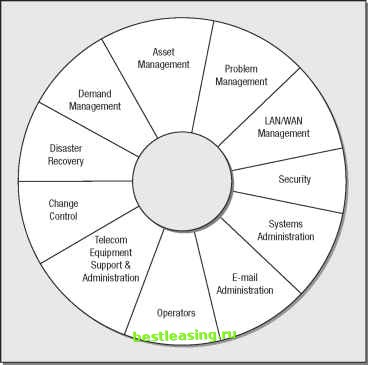

 |
 |

|
Промышленный лизинг
Методички
Create and refine standards Set technology standards(covered previously in this chapter) Clearly document standards by area, with rationale Refine iteratively with feedback from IT team
Introduce standard setting process, and benefits with IT steering committee Review IT standards by area with SC Refine standards with feedback from business units Get cover page signoff from IT steering committee members Get final IT team signoff on new standards Introduce standards to finance department (Cap approval) and purchasing department Change purchasing/ approval process to include IT approval for technology related Capex or other purchases Route technology purchasing through IT department where possible Implement standards Analyze/ recommend and Steady state approve new management purchases Locate all points of entry for procurement of new technology in the organization For all new procurement (through IT department or other department) Assess procurement requests Update standards if needed Document exceptions to standards where business case can be made Assess current technology platform Ongoing management Quarterly (or more frequent) review and update of standards Should be part of the IT department operating calendar Reiterate overall process of documentation, review and update Update technology platform Assess technology groups in existing technology platform Analyze adherence to standards Identify, document and understand implications of previous standard exceptions Existing technology lifecycle analysis Retire/reacquire end-of-lifecycle assets Develop plan for migrating existing platform to homogeneous environment Keep IT steering committee apprised of plan and progress Exhibit 17.5 Process for Determining and Setting Standards by Area be set and soliciting input. Then, send an e-mail identifying the particular standard with a discussion addressing the point raised in the first round of discussions. People like to be asked their opinions but oftentimes become jaded when it appears that their opinions were totally ignored. If the standard does not incorporate the opinion, a discussion attached to the standard should raise the issue and identify why it was not adopted. Standards limit creativity and, as such, technical people often abhor standards. Perhaps even the same person who wrote the original standard, when faced with a different situation, might opt to ignore the standard. But the standard cannot be ignored. It must either be applied or modified. For example, you are attempting to create an integrated document management system (DMS) throughout your enterprise. Assume you set a standard for your system, DMS-A. All of your offices except one purchased DMS-A, and you begin to integrate the solutions. One office, however, purchased DMS-B because they believed DMS-B was a better solution. It provided some additional functionality and fit better into their environment. This refusal to follow standards is sure to cause problems. First, even if DMS-A and DMS-B will integrate, that integration will be harder than simply integrating the same system worldwide. Second, your central project team, and any centralized support that may be required, must now learn two systems, DMS-A and DMS-B. Third, any future developments that you may consider must now also consider and test against each of the two DMSs. You have increased the complexity of your network, increased the cost of maintaining your systems, and increased the cost and complexity of future projects by failing to enforce the standard. Operations The road to good intentions is paved with hell. -Donald E.Walker, Never Try to Teach a Pig to Sing IT operations refers to the utility services provided by the IT department. IT operations generally covers management of hardware, network, network security, enterprise security, communications, user administration, and e-mail systems. Approaches for effectively managing the operations area by implementing standard operating procedures (SOPs) for the most common, repetitive tasks are provided. This section also covers techniques for improving quality through process improvement and root cause analysis for diagnosing system problems. Additionally, it covers methods for calculating appropriate staffing levels for the operations areas. The operations unit most often receives only negative attention when service outages occur, and rarely receives positive recognition. The techniques discussed in this section can help raise the visibility, service level, and positive feedback in the organization. Scope of Operations Operations incorporates the following processes and areas as shown in Exhibit 17.6: Problem management (help desk) LAN/WAN infrastructure and services management Systems and network security management Systems administration (patches, upgrades, tuning) E-mail administration User login and profile management.  Exhibit 17.6 IT Operations 1 2 3 4 5 6 7 8 9 10 11 12 13 14 15 16 17 18 19 20 21 22 23 24 25 26 27 28 29 30 31 32 33 34 35 36 37 38 39 40 41 42 43 44 45 46 47 48 49 50 51 52 53 54 55 56 57 58 59 60 61 62 63 64 65 66 67 68 69 70 71 72 73 74 75 76 77 78 79 80 81 82 83 84 85 86 87 88 89 90 91 92 93 94 95 96 97 98 99 100 101 102 103 104 105 106 107 108 109 110 111 112 113 114 115 116 117 118 119 120 121 122 123 124 125 126 127 128 129 130 131 132 133 134 135 136 137 138 139 140 141 142 143 144 145 146 147 148 149 150 151 152 153 [ 154 ] 155 156 157 158 159 160 161 162 163 164 165 166 167 168 169 170 171 172 173 174 175 176 177 178 179 180 181 182 183 184 185 186 187 |